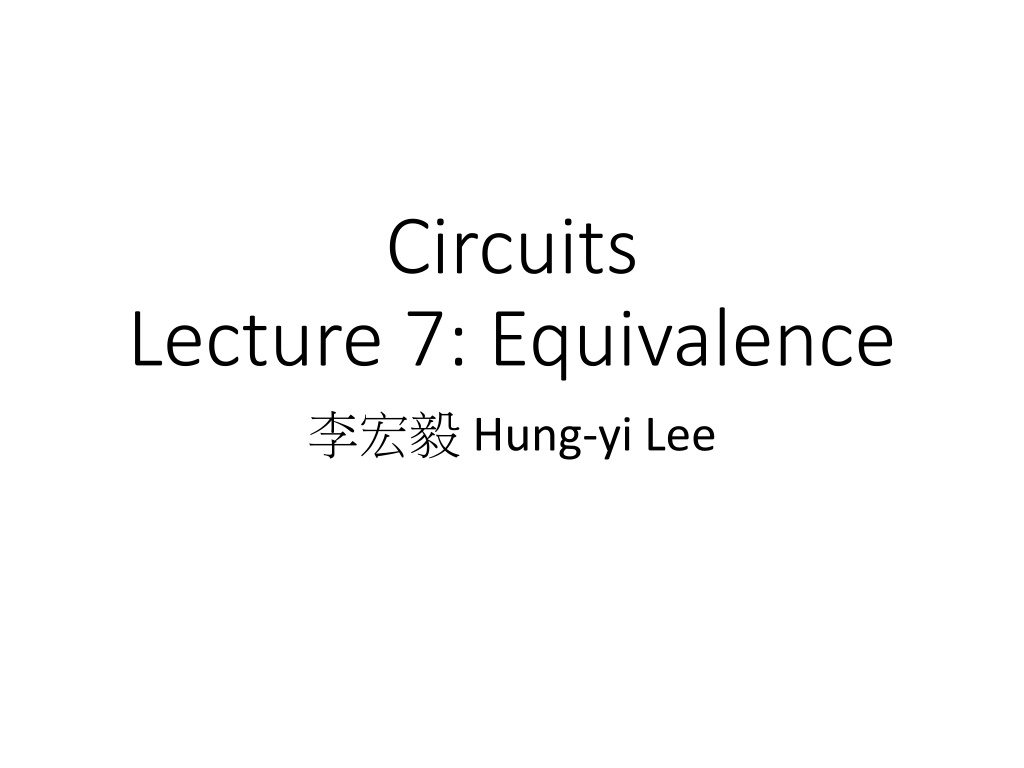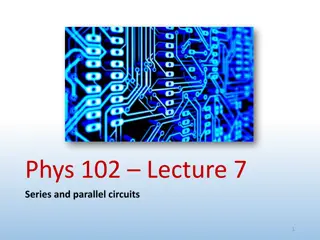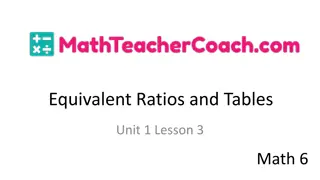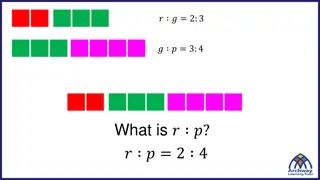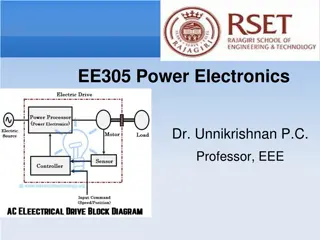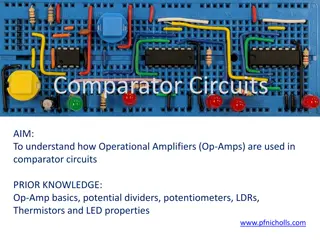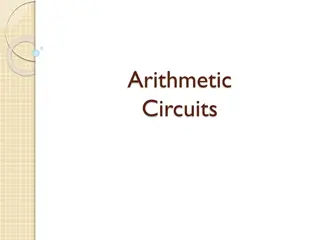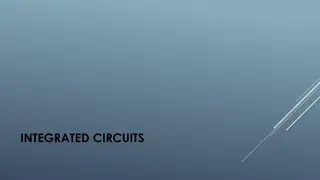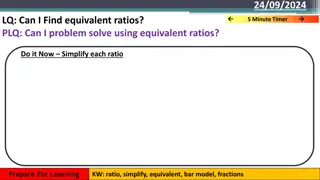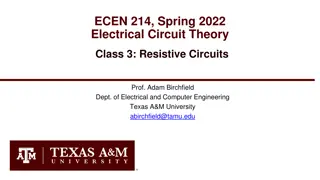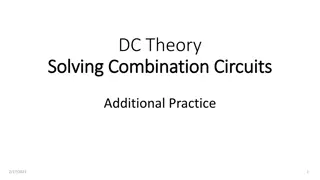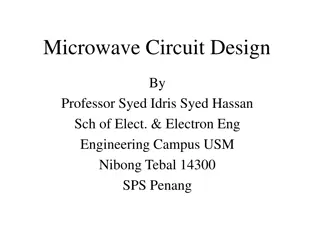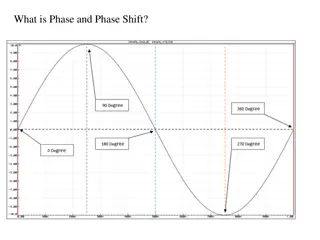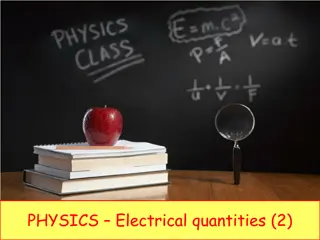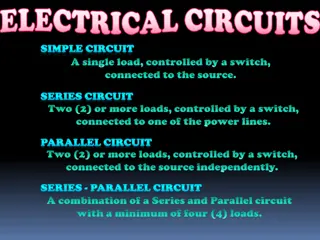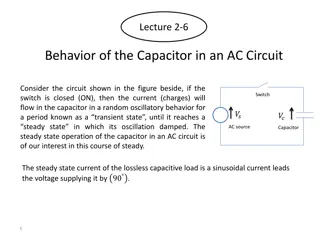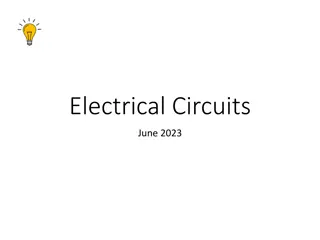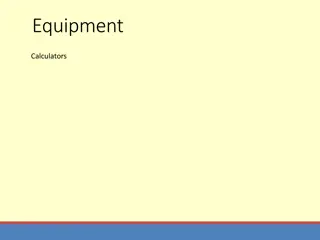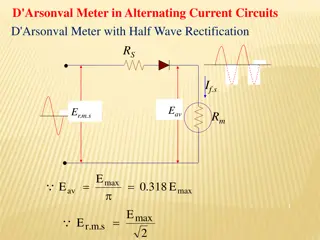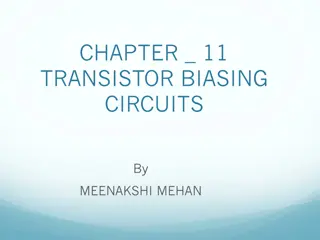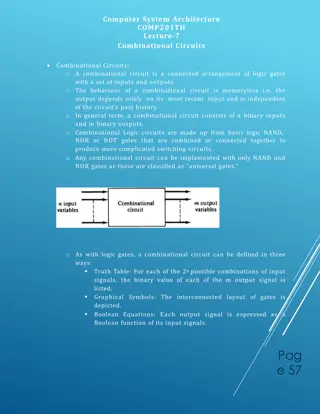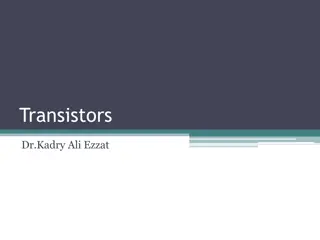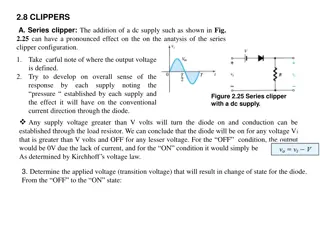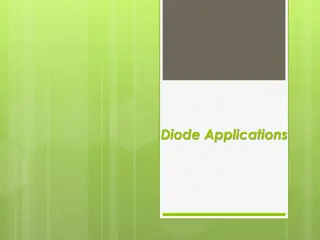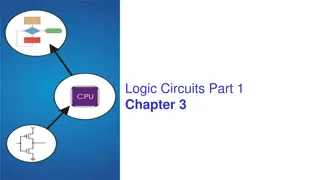Understanding Equivalent Networks in Circuits
Explore the concept of equivalent networks in circuits, detailing how they simplify complex circuits, along with comparisons to programming functions. Delve into the parallels between circuit design and programming, highlighting the importance of structuring circuits like functions. Discover the benefits of equivalent networks and how they aid in simplifying circuit analysis.
Download Presentation

Please find below an Image/Link to download the presentation.
The content on the website is provided AS IS for your information and personal use only. It may not be sold, licensed, or shared on other websites without obtaining consent from the author. Download presentation by click this link. If you encounter any issues during the download, it is possible that the publisher has removed the file from their server.
E N D
Presentation Transcript
Circuits Lecture 7: Equivalence Hung-yi Lee
Textbook Chapter 2.1, 2.3
Outline Concept of Equivalent networks Equivalent networks only with resistors Equivalent networks with independent sources Equivalent networks with controlled sources
Outline Concept of Equivalent networks Equivalent networks only with resistors Equivalent networks with independent sources Equivalent networks with controlled sources
Network Network: Part of a complete circuit Two-terminal network
Equivalent Network i-v characteristics i i i Network A Network B v v v Network A and B are equivalent. Equivalent networks in circuits are just like functions in programming!
Circuit Design is like Programming int main () { // create array of grades double quiz1_grade[50] = double total = 0; for (int i=0; i<50; i++){ total += quiz1_grade[i]; } double avg = total / 50; print avg; The complete circuit is the main . return 0; } Put everything in main is not a good idea. (the program for computing the average score of the first quiz)
Circuit Design is like Programming Define IO of a function: input: double array (scores) output: double (average score) Use function int main () { function avg_score(double* score){ // create array of grades double quiz1_grade[50] = double total = 0; for (int i=0; i<50; i++){ total += score[i]; } return total/50; print avg_score(quiz1_grade); We do not care what happens in the function. } } Understandable name Easy to read! Can be re-used!
Circuit Design is like Programming Complete Circuit (Main) Network (function) Function Name??? 6 k i-v characteristics i Simpler equivalent network (function name) v 6 k (IO of function)
Benefit of Equivalent Network 1. Simplify the complete circuit Easier to analyze 2. Useful network can be reused just like elements Voltage amplifier (refer to lecture 5) Current source (later) Negative Resistor (later)
Outline Concept of Equivalent networks Equivalent networks only with resistors Equivalent networks with sources Equivalent networks with controlled sources
i-v curse Series 1 + = slope R R 1 2 = + = + v v ( v R i R i 1 2 1 2 = + ) R R i 1 2 v + = i R R 1 2
i-v curse Parallel 1 R 1 R = + slope 1 2 v v 1 = + = + = i i i R 1 2 1 R 1 R R R par + 1 2 1 1 1 R 2 = + v R = 1 + 2 R R R 1 2 R 1 2
Example 2.4 + + = 4 5 6 15 k k k k Find i = 20 || 20 10 k k k = = 40 / 8 mA 5 i k = k 6 10 || 15 k k
Beyond Series and Parallel Req = What is Req? Find i-v characteristics Way1: Add voltage source find current Way2: Add current source find voltage
Cubic Puzzle Req = What is Req? A and B are the two terminals of the network. Hint: consider i-v characteristics All resistors have resistance R.
Cubic Puzzle 2 (solution is at the end of the slides)
Infinity Puzzle = Req Infinite resistors What is Req? (solution is at the end of the slides)
Outline Concept of Equivalent networks Equivalent networks only with resistors Equivalent networks with sources Equivalent networks with controlled sources
Sources i-v curse Voltage Sources sv i-v curse Current Sources si
Source Transformation i R sv 1 vs = slope R R v sv = + vs Ri v 1 1 = + i v sv R R
Source Transformation R sv si R v = + = + 1 vs Ri v is i + R v 1 1 = + i v sv = i si R R R v The two circuits are equivalent. s= = s i R R and R
Source Transformation R v s= s i sv R R
Source Transformation R si = v i R s s R
Why Source Transformation? Parallel
Why Source Transformation? Series Be careful about the directions of voltage and current sources
Example Find vo Simply the networks by their equivalent networks
Example Find vo Network B Network A
Example How about . Find vo Bad idea Do not put the target in the network to be simplified.
Example Find vo Two-terminal Network
Example Find equivalent network Typical Network 3
Example Find equivalent network 3 3
Example 2 . 3 = vo V 2 3 4 V = 2 6 || 3
Outline Concept of Equivalent networks Equivalent networks only with resistors Equivalent networks with sources Equivalent networks with controlled sources
Equivalent Network with Controlled Source Example 2.8 What is the equivalent network? Find the i-v characteristics v R = i i i =1 = R Resistor R C eq i g R v m = g v m R 1 = = Req R 2 gm R g R = m v R Negative Resistor!
Source Transformation for Controlled Sources vc ic v c= c i c= v i R c R
Equivalent Network with Controlled Source Example 2.8 i + R v cv = = = i i i v i R g vR R C c c m v = g v m = + R 1 v = iR + v c g R iR g vR = m v m R
Remind 1 When computing i-v characteristics, we need reference direction of v and i Without reference direction, we cannot really answer the i-v characteristics Network without sources Network with sources i i + v + v Load Network Source Network i i The current goes into the terminal with high potential. The current goes out the terminal with high potential.
Remind 2 Select good networks Put a controlled source and its control variable in the same network
Three-terminal Network Three-terminal network Chapter 4.6 (out of the scope)
Four-terminal Network Chapter 14
Problem 2.32, 2.36
Beyond Series and Parallel Req = What is Req? Find i-v characteristics: Way1: Add voltage source find current Ans:1.1K Way2: Add current source find voltage
Cubic Puzzle Req = What is Req? 1 1 1 All resistors have resistance R. = + + v iR iR iR 3 6 3 A and B are the two terminals of the network. 5 = R R eq 6
Cubic Puzzle 2 5 . 1 http://e2e.ti.com/blogs_/archives/b/thesignal/archive/2013/03/18/resistor- puzzle-solution-and-a-rant-on-schematics.aspx?DCMP=scblog&HQS=hpa-pa- opamp-thehub-20140129-thesignal-20130318-en
Infinity Puzzle = Req Infinite resistors What is Req? ( 1+ )R = 3 Req https://www.youtube.com/watch?v=MgN7h1z5bMQ (the answer in the video is not correct)
Problem - Answer 2.32 6? 2.36 (a) What if ? = 1? (b) (5 0.5?)K (c) ? = 12
Brain Teaser 1 1 V 1 A 1 http://rochester.ieee.org/files/2014/03/Newsletter_4-2014.pdf
Acknowledgement (b02) Infinity Puzzle
